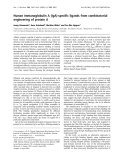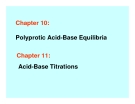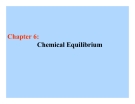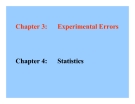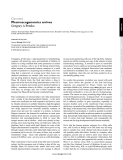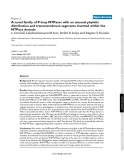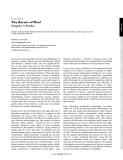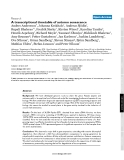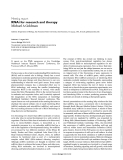
Engineering biotechnology
-
Affinity reagents capable of selective recognition of the different human immunoglobulin isotypes are important detection and purification tools in biotechnology. Here we describe the development and characterization of affinity proteins (affibodies) showing selective binding to human IgA. From protein libraries constructed by combinatorial mutagenesis of a 58-amino-acid, three-helix bundle domain derived from the IgG-binding staphylococcal protein A, variants showing IgA binding were selected by using phage display technology and IgA monoclonal antibodies (myeloma) as target molecules. ...
 9p
9p  system191
system191
 01-06-2013
01-06-2013
 39
39
 3
3
 Download
Download
-
An applied field of biology that involves the use of living organisms and bioprocesses in engineering, technology, medicine and other fields requiring bioproducts. (http://en.wikipedia.org/wiki/Biotechnology) It is the products and exploitation from other fundamental sciences.Traditional Biotechnology Traditional biotechnology refers to a number of ancient ways of using living organisms to make new products or modify existing ones. In its broadest definition, traditional biotechnology can be traced back to human's transition from hunter-gatherer to farmer.
 29p
29p  zingzing09
zingzing09
 24-04-2013
24-04-2013
 63
63
 8
8
 Download
Download
-
Microorganisms produce a large number of pharmaco-logically and biotechnologically important peptides by using nonribosomal peptide synthetases (NRPSs). Due to their modular arrangement and their domain organization NRPSs are particularly suitable for engineering recom-binant proteins for the production of novel peptides with interesting properties.
 9p
9p  fptmusic
fptmusic
 12-04-2013
12-04-2013
 60
60
 3
3
 Download
Download
-
Standards for standardization of reducing agents: K2Cr2O7 KIO3 Ce4+ Standards for standardization of oxidizing agents: Na2C2O4 Na2S2O3 Fe2+ (Mohr’s salt and Oesper’s salt) 4 .V. Auxiliary Oxidizing and Reducing Agents The analyte must be in a single oxidation state at the start of the titration. This can be achieved by using a preoxidation or pre-reduction step prior to analysis
 25p
25p  doilan
doilan
 26-01-2013
26-01-2013
 50
50
 4
4
 Download
Download
-
Oxidation/Reduction Reactions Reactions in which electrons are transferred from one reactant to another. Example I-1 Cu2+ + Zn (s) Cu (s) + Zn2+ Cu2+ has undergone reduction and is reduced. Oxidizing reagent: Cu2+. Reducing agent: Zn. Zn has undergone oxidation and is oxidized. .
 91p
91p  doilan
doilan
 26-01-2013
26-01-2013
 66
66
 10
10
 Download
Download
-
Coordinate covalent bonds: a bond formed when both electrons of the bond are donated by one atom. [H3N: Ag :NH3]+ Ag+ + 2(:NH3) Electron configuration of Ag [Kr]4d105s15P0 Ag+ [Kr]4d105s0 5P0 Sp hybrid orbitals: accommodate 2 pairs of electrons. Linear Complex ion: A metal ion with Lewis base attached to it through coordinate covalent bond. Complex (Coordinate compound): a compound consisting either of complex ions and other ions of opposite charge or of neutral complex species.
 49p
49p  doilan
doilan
 26-01-2013
26-01-2013
 68
68
 7
7
 Download
Download
-
Treating Complex Acid-Base Systems Complex systems are defined as solutions made up of: 1) Two acids or bases of different strengths HCl + CH3COOH NaOH + CH3COO2) An acid or base that has two or more acidic protons or basic functional groups H3PO4 Ca(OH)2 .3) An amphiprotic substance that is capable of acting as both acid and base HCO3- + H2O CO32- + H3O+ HCO3- + H2O H2CO3 + OHNH3+CH2COO- + H2O NH2CH2COO- + H3O+ NH3+CH2COO- + H2O NH3+CH2COOH + OH- .
 46p
46p  doilan
doilan
 26-01-2013
26-01-2013
 78
78
 7
7
 Download
Download
-
Solutions and Indicators for Neutralization Titrations A. Standard Solutions: The standards solutions used as titrants for unknown w eak acids or bases are alw ays strong bases or acids, respectively. Standard titrant acids: dilute solutions of HCl, HClO 4 , or H 2 SO 4 . Standard titrant bases: dilute solutions of NaOH, KOH. The primary standards may not be strong acids or bases (e.g., potassium acid phthalate, sodium oxalate, sodium bicarbonate).
 43p
43p  doilan
doilan
 26-01-2013
26-01-2013
 68
68
 7
7
 Download
Download
-
individual species Determining which species are present Reactions Equations Assumption Steps in Figure 9-1 .A Systematic Method .
 39p
39p  doilan
doilan
 26-01-2013
26-01-2013
 36
36
 4
4
 Download
Download
-
The concentrations and charge strength of "spectator“ or non-reacting electrolytes The tendency to form precipitates will be decreased with increasing ionic strength 1) interactions (but not necessarily reactions) of the reactant species with other charged species 2) interactions of the charged product species with the spectator ions. H2O + H2CO3 H3O+ + HCO3Ka1 increases with increasing ionic strength, so the solution becomes more acidic.
 36p
36p  doilan
doilan
 26-01-2013
26-01-2013
 46
46
 6
6
 Download
Download
-
Titrimetry refers to that group of analytical techniques which takes advantage of titers or concentrations of solutions. The word "titer" is also used to denote "equivalence" or that amount of a solution required to complete a chemical reaction. Titrimetry often refers to the use of some volume of a solution of known concentration to determine the quantity of an analyte. But there are some variations on the use of the term.
 66p
66p  doilan
doilan
 26-01-2013
26-01-2013
 64
64
 6
6
 Download
Download
-
Electrolytes: solutes which carry electrical charge - these compounds are at least partially ionized 1. Strong Electrolytes = solutes almost completely ionized 2. Weak Electrolytes = solutes only partially ionized .Acids and Bases - electrolytes (can be weak or strong) 1. Bronsted-Lowery Theory: acids are proton donors bases are proton acceptors 2. Strong Acids and bases almost completely ionized 3. Weak acids and bases (poorly ionized). See Table 6-2 (memorize strong acids and bases)
 33p
33p  doilan
doilan
 26-01-2013
26-01-2013
 38
38
 5
5
 Download
Download
-
Establishing confidence limits for a mean of a set of replicate data Determining the number of replications Determining at a given probability whether an experimental mean is at the acceptable range Determining at a given prob.Term & Definition Confidence Limit (CL): define an interval around mean ( x ) that probably contains population mean (μ). ...
 36p
36p  doilan
doilan
 26-01-2013
26-01-2013
 41
41
 4
4
 Download
Download
-
Data of unknown quality are useless! All laboratory measurements contain experimental error. It is necessary to determine the magnitude of the accuracy and reliability in your measurements. Then you can make a judgment about their usefulness. Replicates - two or more determinations on the same sample Example 3-1: One student measures Fe (III) concentrations six times. The results are listed below: 19.4, 19.5, 19. 6, 19.8, 20.1, 20.3 ppm (parts per million) 6 replicates = 6 measurements The "middle" or "central" value for a group of results: Mean: average or arithmetic mean ...
 67p
67p  doilan
doilan
 26-01-2013
26-01-2013
 55
55
 6
6
 Download
Download
-
Tham khảo bài thuyết trình 'analytical chemistry', khoa học tự nhiên, hoá học phục vụ nhu cầu học tập, nghiên cứu và làm việc hiệu quả
 61p
61p  doilan
doilan
 26-01-2013
26-01-2013
 78
78
 9
9
 Download
Download
-
It happens all the time: a pharmaceutical or biotechnology company will spend ten years and hundreds of millions of dollars on a drug candidate that looks spectacular in animal models of a disease, only to see it fail during clinical trials, either because of unexpected adverse reactions in a small number of patients or a surprising lack of efficacy. For every drug that is approved, on average more than 6,000 new chemical substances are created. Only seven of these ever end up being tested in humans, and only three make it to Phase III clinical trials, the final step before...
 0p
0p  thulanh21
thulanh21
 15-11-2011
15-11-2011
 51
51
 2
2
 Download
Download
-
L Aravind, Lakshminarayan M Iyer, Detlef D Leipe and Eugene V Koonin Address: National Center for Biotechnology Information, National Library of Medicine, National Institutes of Health, Bethesda, MD 20894, USA. reviews Correspondence: L Aravind. E-mail: aravind@ncbi.nlm.nih.gov Published: 16 April 2004 Genome Biology 2004, 5:R30 The electronic version of this article is the complete one and can be found online at http://genomebiology.com/2004/5/5/R30 Received: 19 January 2004 Revised: 8 March 2004 Accepted: 11 March 2004 reports © 2004 Aravind et al.
 0p
0p  thulanh21
thulanh21
 15-11-2011
15-11-2011
 57
57
 1
1
 Download
Download
-
Anyone who cares about the moral and social implications of genomics, genetic engineering and biotechnology should read Michael J. Sandel’s article, ‘The Case Against Perfection’, in the April 2004 issue of The Atlantic Monthly. Sandel, the Anne T. and Robert M. Bass Professor of Government at Harvard University (where he teaches moral philosophy), is one of the deepest thinkers of this generation. He is a member of The President’s Council on Bioethics, which George W. Bush established to make recommendations concerning stem-cell research, among other issues. In this essay, with...
 0p
0p  thulanh21
thulanh21
 15-11-2011
15-11-2011
 53
53
 1
1
 Download
Download
-
Volume et al.
 0p
0p  thulanh21
thulanh21
 15-11-2011
15-11-2011
 55
55
 1
1
 Download
Download
-
We have come so far so fast in understanding RNA interference (RNAi) and its central role in biology. Rarely has a novel mechanism in molecular genetics had such broad implications, ranging from gene therapy and drug discovery to our very understanding of what the word ‘gene’ means. Every major pharmaceutical company has a substantial effort now in RNAi technology, and among the smaller biotechnology companies RNAi is the mainstay of several, with
 3p
3p  thulanh19
thulanh19
 09-11-2011
09-11-2011
 46
46
 2
2
 Download
Download
CHỦ ĐỀ BẠN MUỐN TÌM








